Economics 3307: Money and Banking Assignment, Summer 2018
VerifiedAdded on 2023/06/09
|9
|1959
|235
Homework Assignment
AI Summary
This document presents a comprehensive solution to a Money and Banking assignment, covering key concepts in finance. The assignment begins with an analysis of coupon bonds, requiring the calculation of current yields for various Canadian bonds and a comparison with yield to maturity. The next section delves into the term structure of interest rates, utilizing the yieldcurve.com website to examine upward and inverted yield curves, and discusses the implications of the term structure theories. The assignment also explores bond duration, calculating it under different market interest rate scenarios and analyzing the relationships between interest rates, coupons, and duration. Finally, it includes a critical evaluation of a financial advisor's advice on long-term bond investments. The student provides calculations, graphs, and explanations to support their answers, demonstrating an understanding of bond valuation, interest rate dynamics, and financial market analysis. This assignment is a valuable resource for students studying finance and economics.
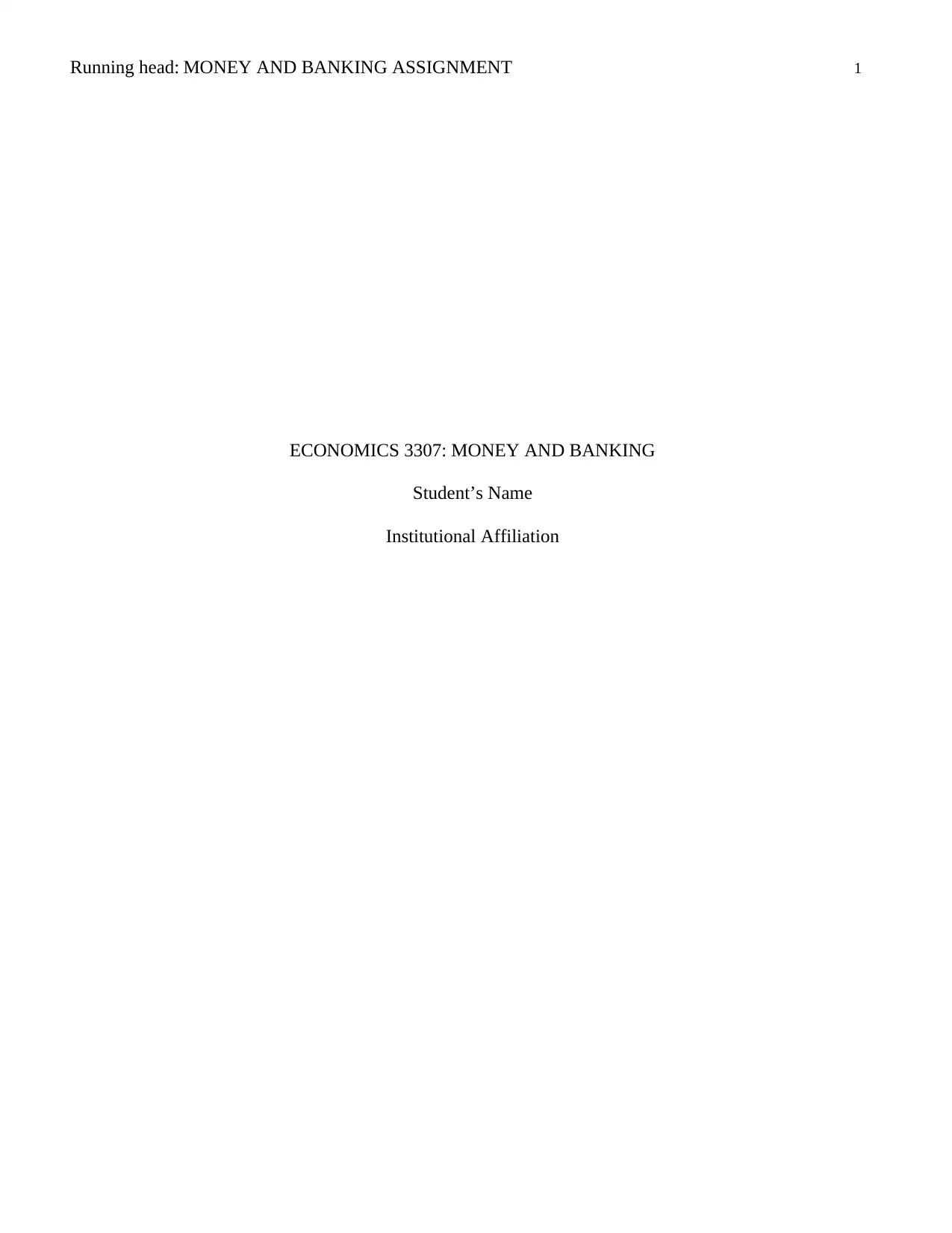
Running head: MONEY AND BANKING ASSIGNMENT 1
ECONOMICS 3307: MONEY AND BANKING
Student’s Name
Institutional Affiliation
ECONOMICS 3307: MONEY AND BANKING
Student’s Name
Institutional Affiliation
Paraphrase This Document
Need a fresh take? Get an instant paraphrase of this document with our AI Paraphraser
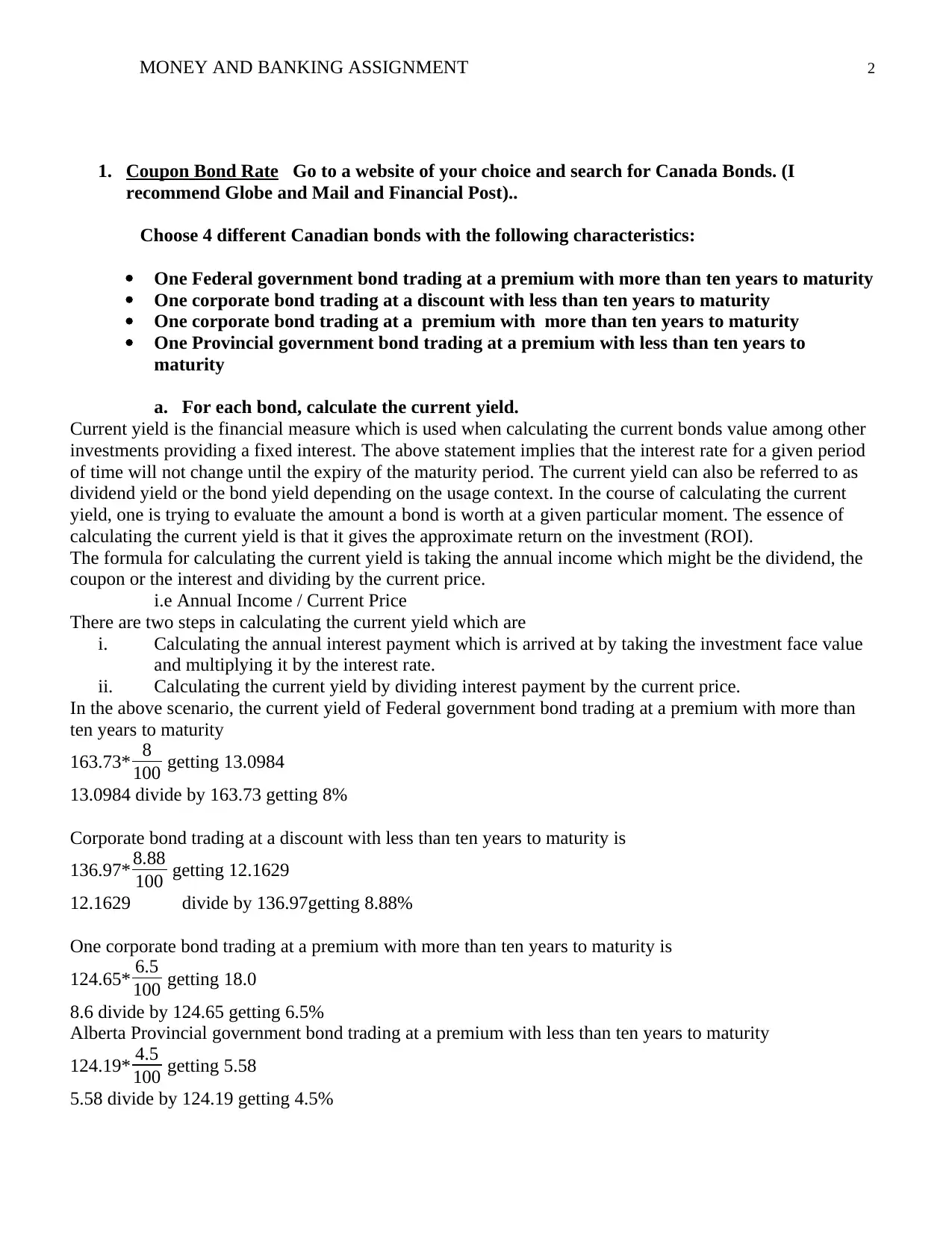
MONEY AND BANKING ASSIGNMENT 2
1. Coupon Bond Rate Go to a website of your choice and search for Canada Bonds. (I
recommend Globe and Mail and Financial Post)..
Choose 4 different Canadian bonds with the following characteristics:
One Federal government bond trading at a premium with more than ten years to maturity
One corporate bond trading at a discount with less than ten years to maturity
One corporate bond trading at a premium with more than ten years to maturity
One Provincial government bond trading at a premium with less than ten years to
maturity
a. For each bond, calculate the current yield.
Current yield is the financial measure which is used when calculating the current bonds value among other
investments providing a fixed interest. The above statement implies that the interest rate for a given period
of time will not change until the expiry of the maturity period. The current yield can also be referred to as
dividend yield or the bond yield depending on the usage context. In the course of calculating the current
yield, one is trying to evaluate the amount a bond is worth at a given particular moment. The essence of
calculating the current yield is that it gives the approximate return on the investment (ROI).
The formula for calculating the current yield is taking the annual income which might be the dividend, the
coupon or the interest and dividing by the current price.
i.e Annual Income / Current Price
There are two steps in calculating the current yield which are
i. Calculating the annual interest payment which is arrived at by taking the investment face value
and multiplying it by the interest rate.
ii. Calculating the current yield by dividing interest payment by the current price.
In the above scenario, the current yield of Federal government bond trading at a premium with more than
ten years to maturity
163.73* 8
100 getting 13.0984
13.0984 divide by 163.73 getting 8%
Corporate bond trading at a discount with less than ten years to maturity is
136.97* 8.88
100 getting 12.1629
12.1629 divide by 136.97getting 8.88%
One corporate bond trading at a premium with more than ten years to maturity is
124.65* 6.5
100 getting 18.0
8.6 divide by 124.65 getting 6.5%
Alberta Provincial government bond trading at a premium with less than ten years to maturity
124.19* 4.5
100 getting 5.58
5.58 divide by 124.19 getting 4.5%
1. Coupon Bond Rate Go to a website of your choice and search for Canada Bonds. (I
recommend Globe and Mail and Financial Post)..
Choose 4 different Canadian bonds with the following characteristics:
One Federal government bond trading at a premium with more than ten years to maturity
One corporate bond trading at a discount with less than ten years to maturity
One corporate bond trading at a premium with more than ten years to maturity
One Provincial government bond trading at a premium with less than ten years to
maturity
a. For each bond, calculate the current yield.
Current yield is the financial measure which is used when calculating the current bonds value among other
investments providing a fixed interest. The above statement implies that the interest rate for a given period
of time will not change until the expiry of the maturity period. The current yield can also be referred to as
dividend yield or the bond yield depending on the usage context. In the course of calculating the current
yield, one is trying to evaluate the amount a bond is worth at a given particular moment. The essence of
calculating the current yield is that it gives the approximate return on the investment (ROI).
The formula for calculating the current yield is taking the annual income which might be the dividend, the
coupon or the interest and dividing by the current price.
i.e Annual Income / Current Price
There are two steps in calculating the current yield which are
i. Calculating the annual interest payment which is arrived at by taking the investment face value
and multiplying it by the interest rate.
ii. Calculating the current yield by dividing interest payment by the current price.
In the above scenario, the current yield of Federal government bond trading at a premium with more than
ten years to maturity
163.73* 8
100 getting 13.0984
13.0984 divide by 163.73 getting 8%
Corporate bond trading at a discount with less than ten years to maturity is
136.97* 8.88
100 getting 12.1629
12.1629 divide by 136.97getting 8.88%
One corporate bond trading at a premium with more than ten years to maturity is
124.65* 6.5
100 getting 18.0
8.6 divide by 124.65 getting 6.5%
Alberta Provincial government bond trading at a premium with less than ten years to maturity
124.19* 4.5
100 getting 5.58
5.58 divide by 124.19 getting 4.5%
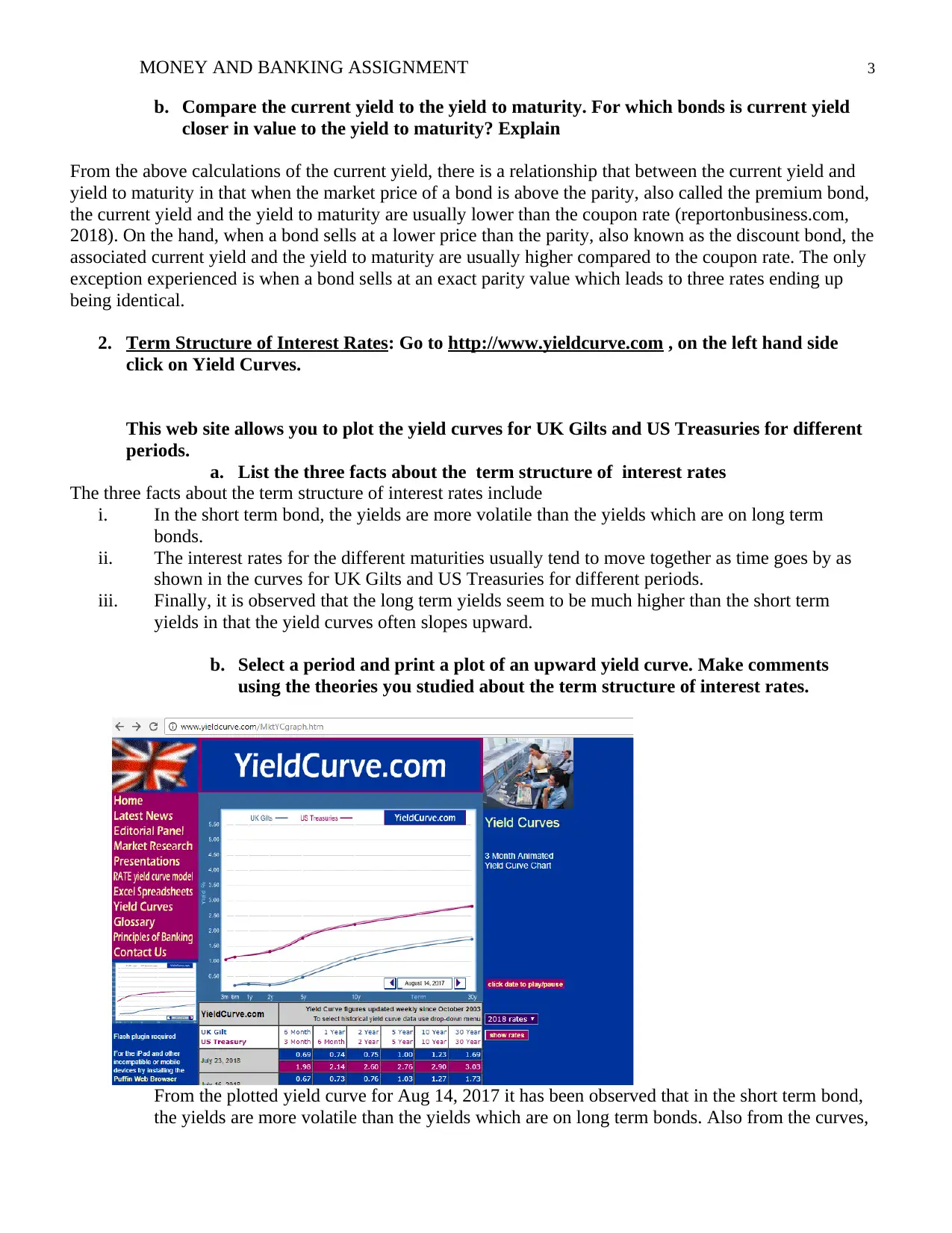
MONEY AND BANKING ASSIGNMENT 3
b. Compare the current yield to the yield to maturity. For which bonds is current yield
closer in value to the yield to maturity? Explain
From the above calculations of the current yield, there is a relationship that between the current yield and
yield to maturity in that when the market price of a bond is above the parity, also called the premium bond,
the current yield and the yield to maturity are usually lower than the coupon rate (reportonbusiness.com,
2018). On the hand, when a bond sells at a lower price than the parity, also known as the discount bond, the
associated current yield and the yield to maturity are usually higher compared to the coupon rate. The only
exception experienced is when a bond sells at an exact parity value which leads to three rates ending up
being identical.
2. Term Structure of Interest Rates: Go to http://www.yieldcurve.com , on the left hand side
click on Yield Curves.
This web site allows you to plot the yield curves for UK Gilts and US Treasuries for different
periods.
a. List the three facts about the term structure of interest rates
The three facts about the term structure of interest rates include
i. In the short term bond, the yields are more volatile than the yields which are on long term
bonds.
ii. The interest rates for the different maturities usually tend to move together as time goes by as
shown in the curves for UK Gilts and US Treasuries for different periods.
iii. Finally, it is observed that the long term yields seem to be much higher than the short term
yields in that the yield curves often slopes upward.
b. Select a period and print a plot of an upward yield curve. Make comments
using the theories you studied about the term structure of interest rates.
From the plotted yield curve for Aug 14, 2017 it has been observed that in the short term bond,
the yields are more volatile than the yields which are on long term bonds. Also from the curves,
b. Compare the current yield to the yield to maturity. For which bonds is current yield
closer in value to the yield to maturity? Explain
From the above calculations of the current yield, there is a relationship that between the current yield and
yield to maturity in that when the market price of a bond is above the parity, also called the premium bond,
the current yield and the yield to maturity are usually lower than the coupon rate (reportonbusiness.com,
2018). On the hand, when a bond sells at a lower price than the parity, also known as the discount bond, the
associated current yield and the yield to maturity are usually higher compared to the coupon rate. The only
exception experienced is when a bond sells at an exact parity value which leads to three rates ending up
being identical.
2. Term Structure of Interest Rates: Go to http://www.yieldcurve.com , on the left hand side
click on Yield Curves.
This web site allows you to plot the yield curves for UK Gilts and US Treasuries for different
periods.
a. List the three facts about the term structure of interest rates
The three facts about the term structure of interest rates include
i. In the short term bond, the yields are more volatile than the yields which are on long term
bonds.
ii. The interest rates for the different maturities usually tend to move together as time goes by as
shown in the curves for UK Gilts and US Treasuries for different periods.
iii. Finally, it is observed that the long term yields seem to be much higher than the short term
yields in that the yield curves often slopes upward.
b. Select a period and print a plot of an upward yield curve. Make comments
using the theories you studied about the term structure of interest rates.
From the plotted yield curve for Aug 14, 2017 it has been observed that in the short term bond,
the yields are more volatile than the yields which are on long term bonds. Also from the curves,
⊘ This is a preview!⊘
Do you want full access?
Subscribe today to unlock all pages.

Trusted by 1+ million students worldwide
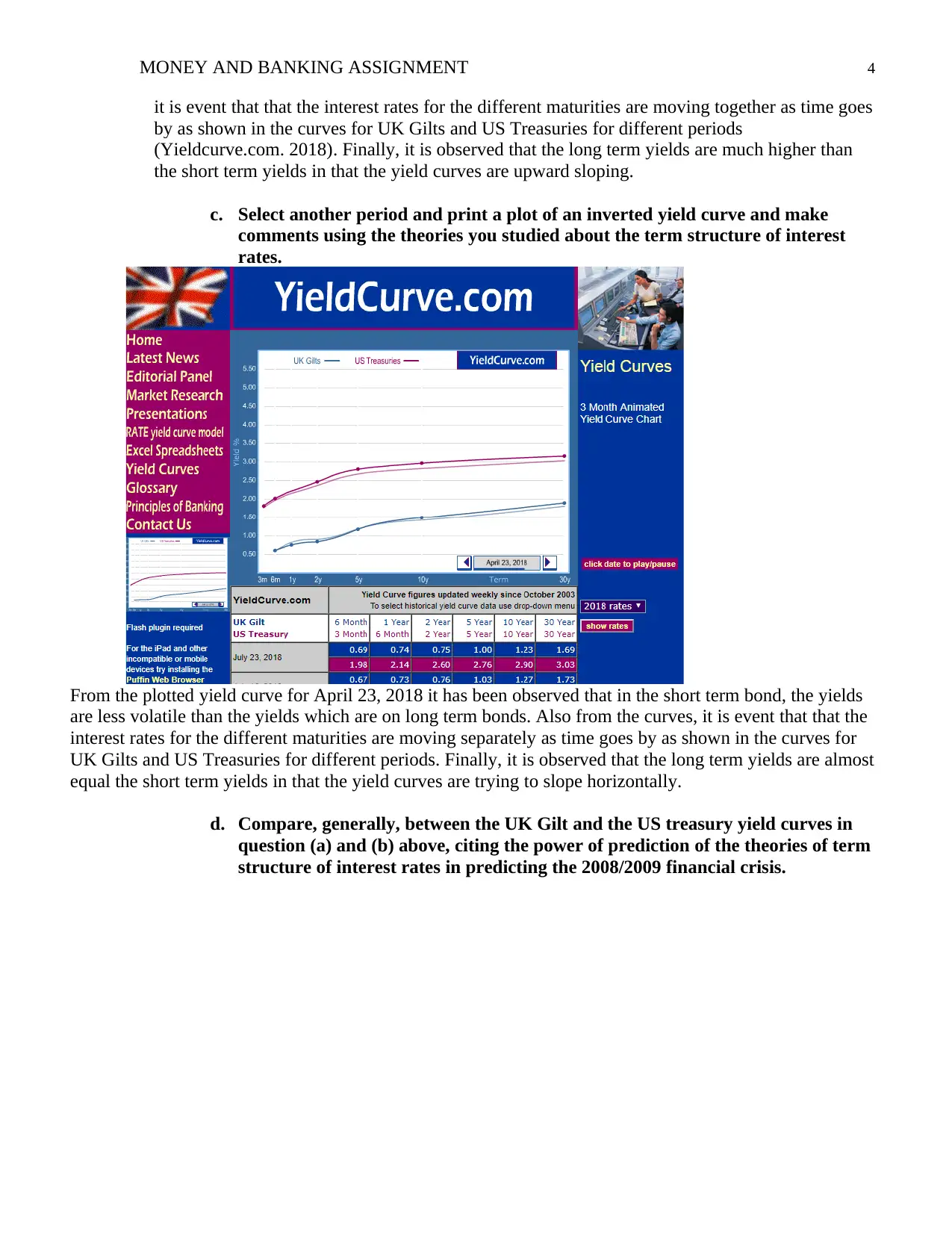
MONEY AND BANKING ASSIGNMENT 4
it is event that that the interest rates for the different maturities are moving together as time goes
by as shown in the curves for UK Gilts and US Treasuries for different periods
(Yieldcurve.com. 2018). Finally, it is observed that the long term yields are much higher than
the short term yields in that the yield curves are upward sloping.
c. Select another period and print a plot of an inverted yield curve and make
comments using the theories you studied about the term structure of interest
rates.
From the plotted yield curve for April 23, 2018 it has been observed that in the short term bond, the yields
are less volatile than the yields which are on long term bonds. Also from the curves, it is event that that the
interest rates for the different maturities are moving separately as time goes by as shown in the curves for
UK Gilts and US Treasuries for different periods. Finally, it is observed that the long term yields are almost
equal the short term yields in that the yield curves are trying to slope horizontally.
d. Compare, generally, between the UK Gilt and the US treasury yield curves in
question (a) and (b) above, citing the power of prediction of the theories of term
structure of interest rates in predicting the 2008/2009 financial crisis.
it is event that that the interest rates for the different maturities are moving together as time goes
by as shown in the curves for UK Gilts and US Treasuries for different periods
(Yieldcurve.com. 2018). Finally, it is observed that the long term yields are much higher than
the short term yields in that the yield curves are upward sloping.
c. Select another period and print a plot of an inverted yield curve and make
comments using the theories you studied about the term structure of interest
rates.
From the plotted yield curve for April 23, 2018 it has been observed that in the short term bond, the yields
are less volatile than the yields which are on long term bonds. Also from the curves, it is event that that the
interest rates for the different maturities are moving separately as time goes by as shown in the curves for
UK Gilts and US Treasuries for different periods. Finally, it is observed that the long term yields are almost
equal the short term yields in that the yield curves are trying to slope horizontally.
d. Compare, generally, between the UK Gilt and the US treasury yield curves in
question (a) and (b) above, citing the power of prediction of the theories of term
structure of interest rates in predicting the 2008/2009 financial crisis.
Paraphrase This Document
Need a fresh take? Get an instant paraphrase of this document with our AI Paraphraser
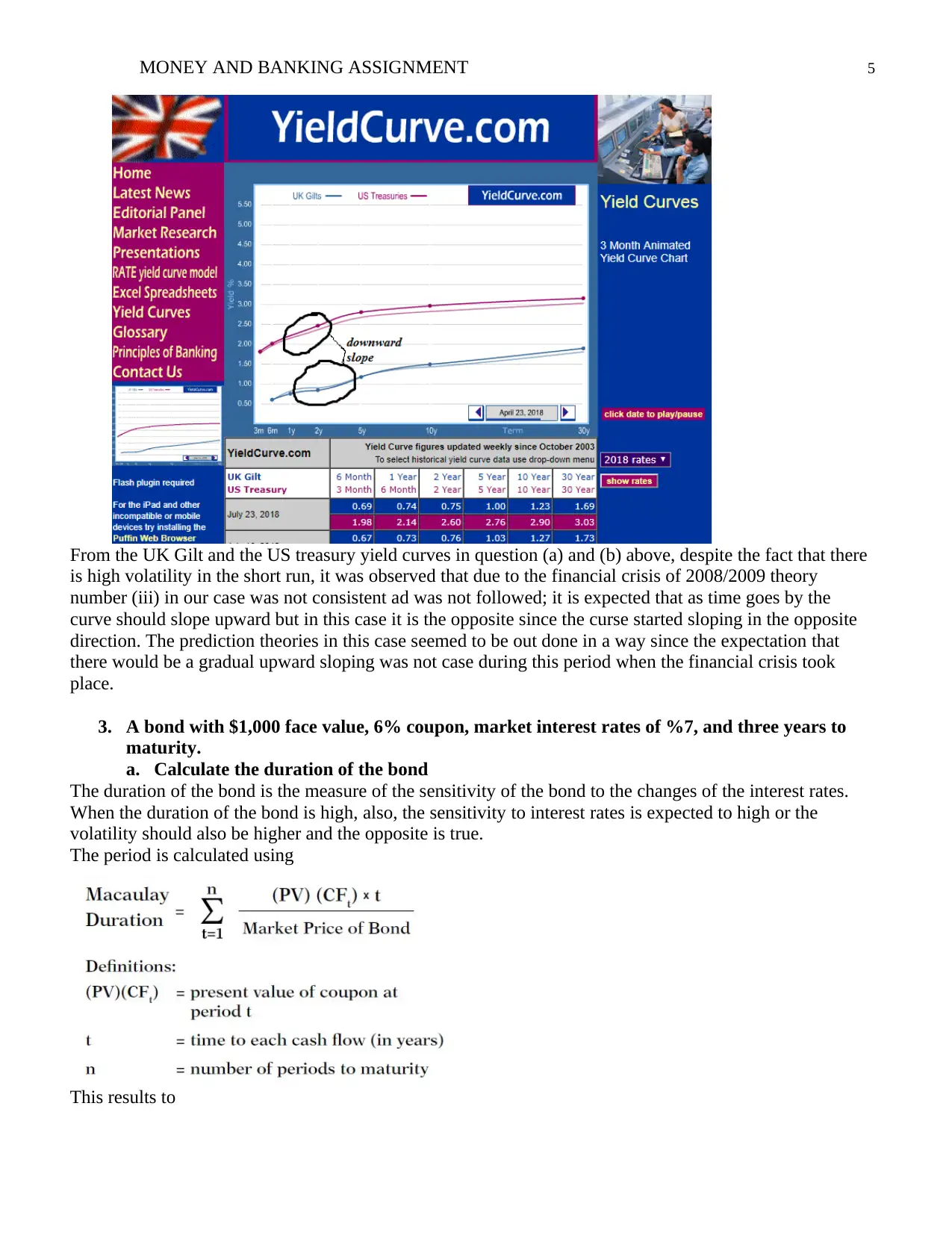
MONEY AND BANKING ASSIGNMENT 5
From the UK Gilt and the US treasury yield curves in question (a) and (b) above, despite the fact that there
is high volatility in the short run, it was observed that due to the financial crisis of 2008/2009 theory
number (iii) in our case was not consistent ad was not followed; it is expected that as time goes by the
curve should slope upward but in this case it is the opposite since the curse started sloping in the opposite
direction. The prediction theories in this case seemed to be out done in a way since the expectation that
there would be a gradual upward sloping was not case during this period when the financial crisis took
place.
3. A bond with $1,000 face value, 6% coupon, market interest rates of %7, and three years to
maturity.
a. Calculate the duration of the bond
The duration of the bond is the measure of the sensitivity of the bond to the changes of the interest rates.
When the duration of the bond is high, also, the sensitivity to interest rates is expected to high or the
volatility should also be higher and the opposite is true.
The period is calculated using
This results to
From the UK Gilt and the US treasury yield curves in question (a) and (b) above, despite the fact that there
is high volatility in the short run, it was observed that due to the financial crisis of 2008/2009 theory
number (iii) in our case was not consistent ad was not followed; it is expected that as time goes by the
curve should slope upward but in this case it is the opposite since the curse started sloping in the opposite
direction. The prediction theories in this case seemed to be out done in a way since the expectation that
there would be a gradual upward sloping was not case during this period when the financial crisis took
place.
3. A bond with $1,000 face value, 6% coupon, market interest rates of %7, and three years to
maturity.
a. Calculate the duration of the bond
The duration of the bond is the measure of the sensitivity of the bond to the changes of the interest rates.
When the duration of the bond is high, also, the sensitivity to interest rates is expected to high or the
volatility should also be higher and the opposite is true.
The period is calculated using
This results to
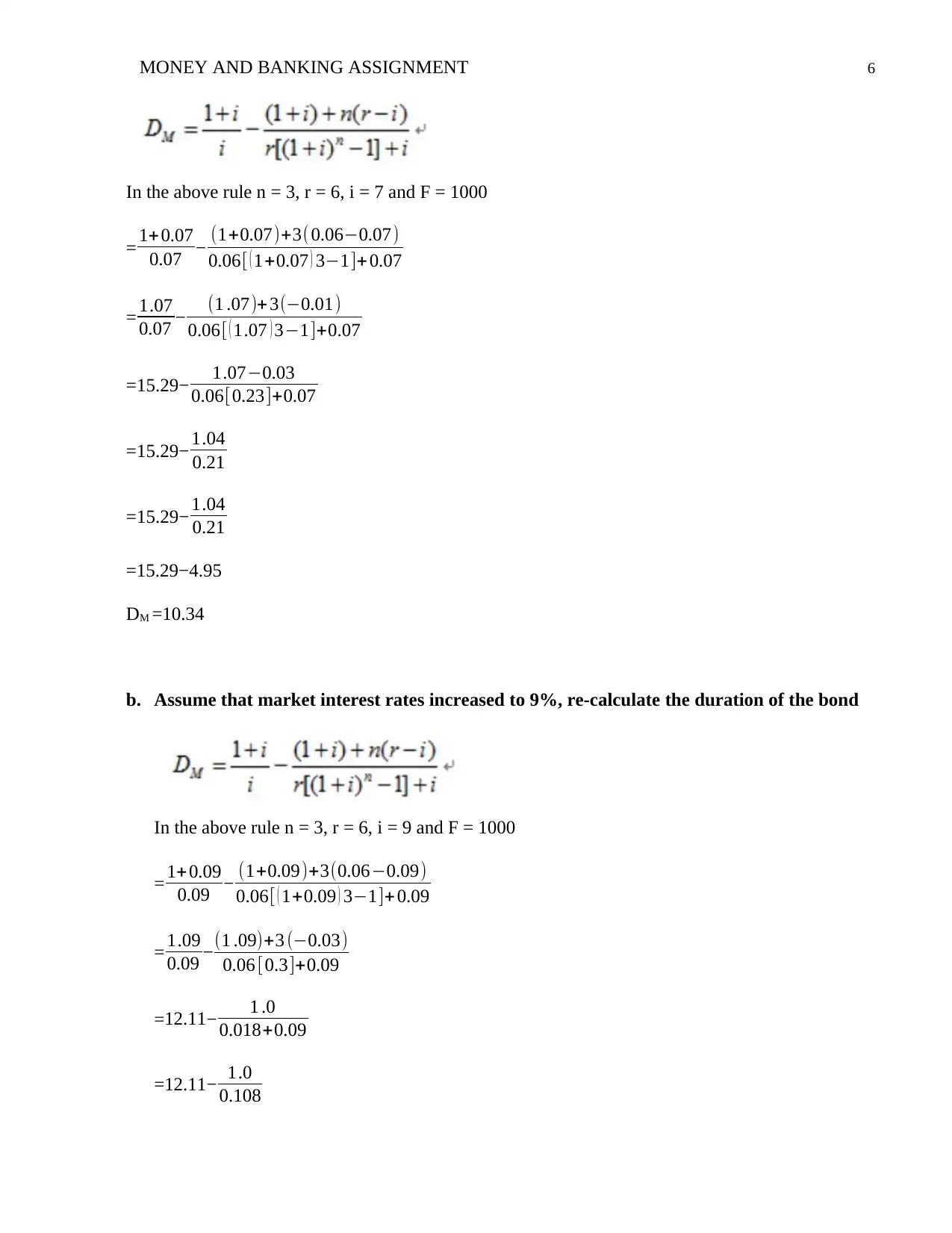
MONEY AND BANKING ASSIGNMENT 6
In the above rule n = 3, r = 6, i = 7 and F = 1000
= 1+ 0.07
0.07 − (1+0.07)+3( 0.06−0.07)
0.06[ ( 1+0.07 ) 3−1]+ 0.07
= 1.07
0.07 − (1 .07)+ 3(−0.01)
0.06[ ( 1.07 ) 3−1]+0.07
=15.29− 1.07−0.03
0.06[0.23]+0.07
=15.29− 1.04
0.21
=15.29− 1.04
0.21
=15.29−4.95
DM =10.34
b. Assume that market interest rates increased to 9%, re-calculate the duration of the bond
In the above rule n = 3, r = 6, i = 9 and F = 1000
= 1+0.09
0.09 − (1+0.09)+3(0.06−0.09)
0.06[ ( 1+0.09 ) 3−1]+ 0.09
= 1.09
0.09 −(1 .09)+3 (−0.03)
0.06 [0.3]+0.09
=12.11− 1 .0
0.018+0.09
=12.11− 1.0
0.108
In the above rule n = 3, r = 6, i = 7 and F = 1000
= 1+ 0.07
0.07 − (1+0.07)+3( 0.06−0.07)
0.06[ ( 1+0.07 ) 3−1]+ 0.07
= 1.07
0.07 − (1 .07)+ 3(−0.01)
0.06[ ( 1.07 ) 3−1]+0.07
=15.29− 1.07−0.03
0.06[0.23]+0.07
=15.29− 1.04
0.21
=15.29− 1.04
0.21
=15.29−4.95
DM =10.34
b. Assume that market interest rates increased to 9%, re-calculate the duration of the bond
In the above rule n = 3, r = 6, i = 9 and F = 1000
= 1+0.09
0.09 − (1+0.09)+3(0.06−0.09)
0.06[ ( 1+0.09 ) 3−1]+ 0.09
= 1.09
0.09 −(1 .09)+3 (−0.03)
0.06 [0.3]+0.09
=12.11− 1 .0
0.018+0.09
=12.11− 1.0
0.108
⊘ This is a preview!⊘
Do you want full access?
Subscribe today to unlock all pages.

Trusted by 1+ million students worldwide
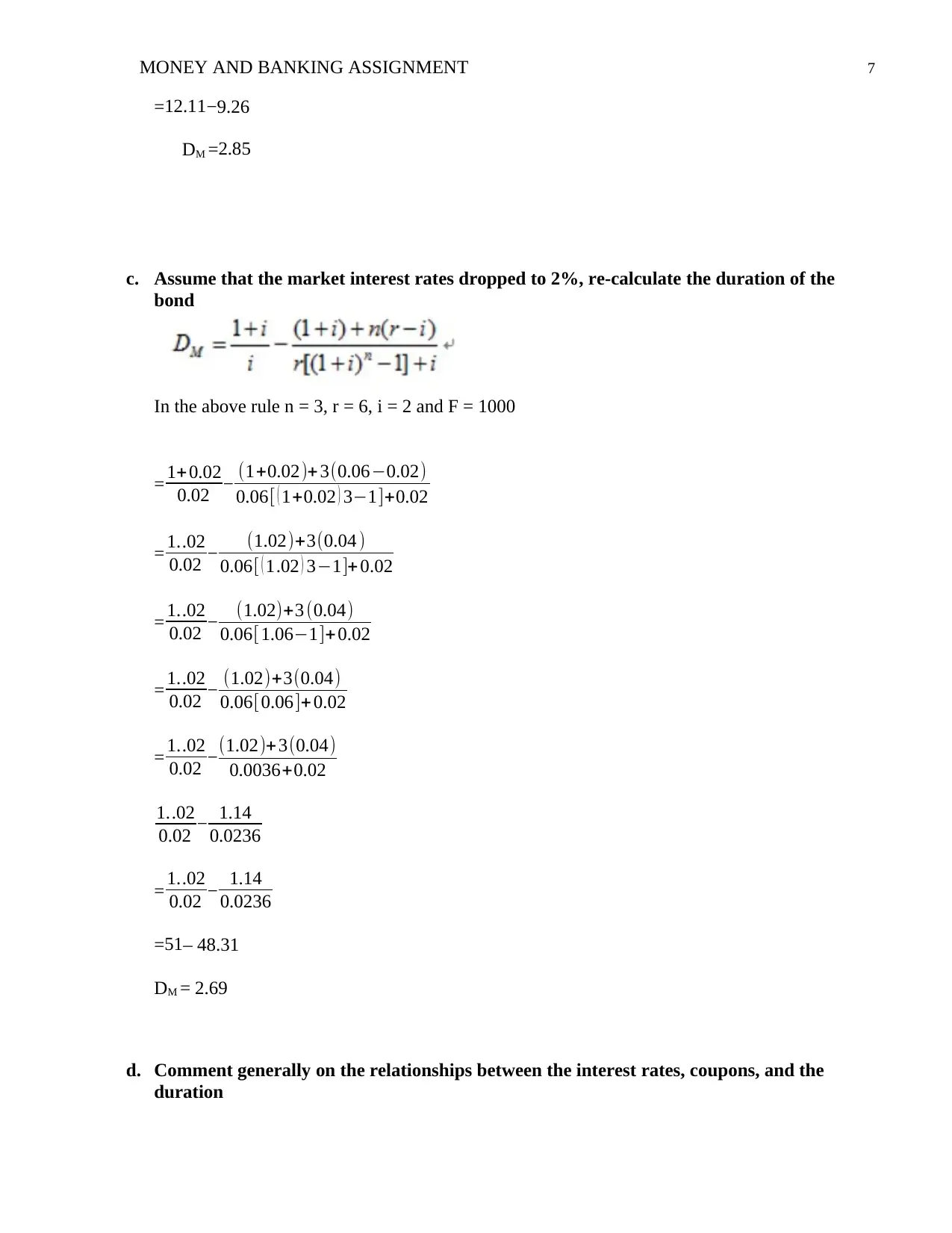
MONEY AND BANKING ASSIGNMENT 7
=12.11−9.26
DM =2.85
c. Assume that the market interest rates dropped to 2%, re-calculate the duration of the
bond
In the above rule n = 3, r = 6, i = 2 and F = 1000
= 1+ 0.02
0.02 − (1+0.02)+ 3(0.06−0.02)
0.06[ ( 1+0.02 ) 3−1]+0.02
= 1..02
0.02 − (1.02)+3(0.04 )
0.06[ ( 1.02 ) 3−1]+ 0.02
= 1..02
0.02 − (1.02)+3 (0.04)
0.06[ 1.06−1]+0.02
= 1..02
0.02 − (1.02)+3(0.04)
0.06[0.06]+ 0.02
= 1..02
0.02 −(1.02)+ 3(0.04)
0.0036+0.02
1..02
0.02 − 1.14
0.0236
= 1..02
0.02 − 1.14
0.0236
=51– 48.31
DM = 2.69
d. Comment generally on the relationships between the interest rates, coupons, and the
duration
=12.11−9.26
DM =2.85
c. Assume that the market interest rates dropped to 2%, re-calculate the duration of the
bond
In the above rule n = 3, r = 6, i = 2 and F = 1000
= 1+ 0.02
0.02 − (1+0.02)+ 3(0.06−0.02)
0.06[ ( 1+0.02 ) 3−1]+0.02
= 1..02
0.02 − (1.02)+3(0.04 )
0.06[ ( 1.02 ) 3−1]+ 0.02
= 1..02
0.02 − (1.02)+3 (0.04)
0.06[ 1.06−1]+0.02
= 1..02
0.02 − (1.02)+3(0.04)
0.06[0.06]+ 0.02
= 1..02
0.02 −(1.02)+ 3(0.04)
0.0036+0.02
1..02
0.02 − 1.14
0.0236
= 1..02
0.02 − 1.14
0.0236
=51– 48.31
DM = 2.69
d. Comment generally on the relationships between the interest rates, coupons, and the
duration
Paraphrase This Document
Need a fresh take? Get an instant paraphrase of this document with our AI Paraphraser
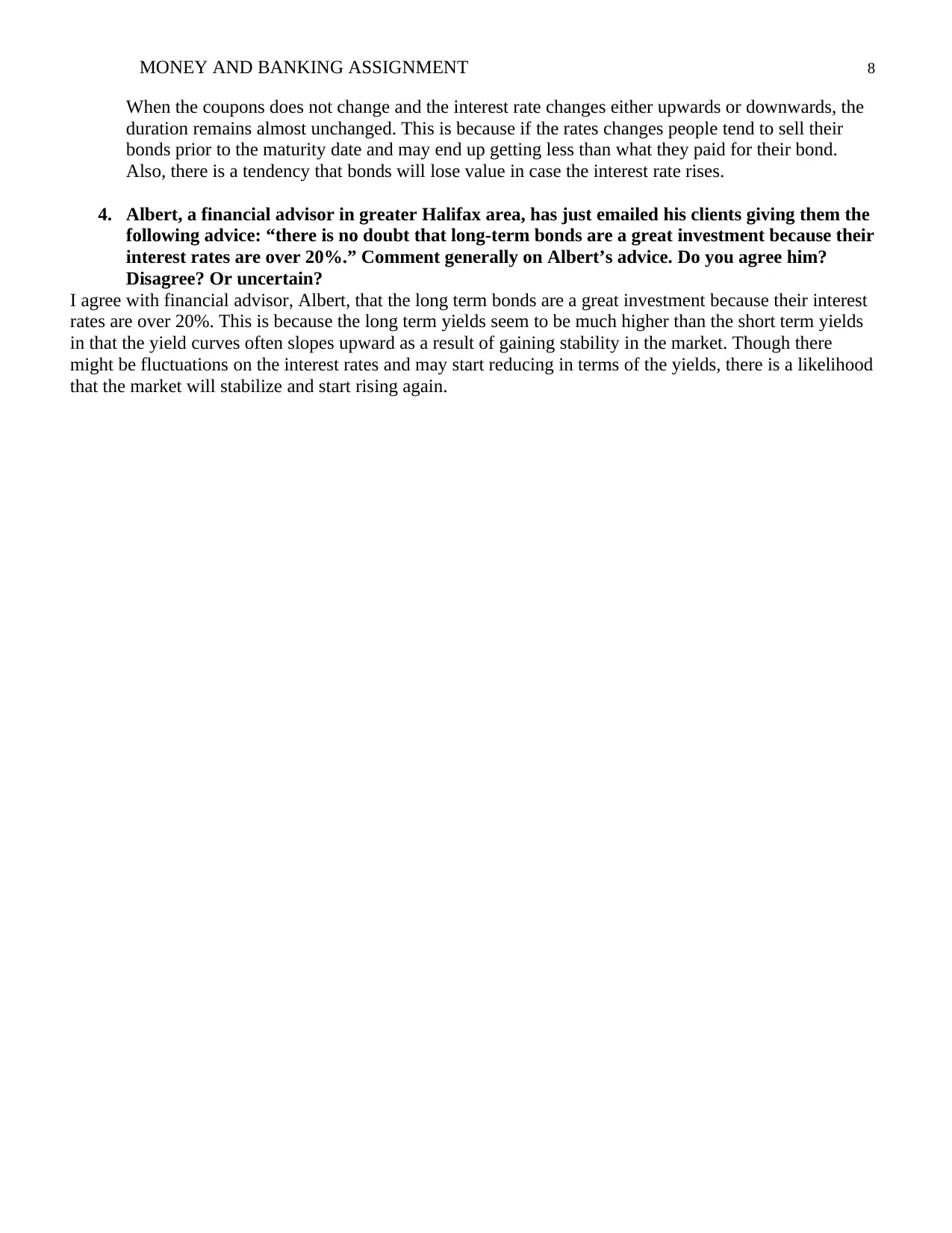
MONEY AND BANKING ASSIGNMENT 8
When the coupons does not change and the interest rate changes either upwards or downwards, the
duration remains almost unchanged. This is because if the rates changes people tend to sell their
bonds prior to the maturity date and may end up getting less than what they paid for their bond.
Also, there is a tendency that bonds will lose value in case the interest rate rises.
4. Albert, a financial advisor in greater Halifax area, has just emailed his clients giving them the
following advice: “there is no doubt that long-term bonds are a great investment because their
interest rates are over 20%.” Comment generally on Albert’s advice. Do you agree him?
Disagree? Or uncertain?
I agree with financial advisor, Albert, that the long term bonds are a great investment because their interest
rates are over 20%. This is because the long term yields seem to be much higher than the short term yields
in that the yield curves often slopes upward as a result of gaining stability in the market. Though there
might be fluctuations on the interest rates and may start reducing in terms of the yields, there is a likelihood
that the market will stabilize and start rising again.
When the coupons does not change and the interest rate changes either upwards or downwards, the
duration remains almost unchanged. This is because if the rates changes people tend to sell their
bonds prior to the maturity date and may end up getting less than what they paid for their bond.
Also, there is a tendency that bonds will lose value in case the interest rate rises.
4. Albert, a financial advisor in greater Halifax area, has just emailed his clients giving them the
following advice: “there is no doubt that long-term bonds are a great investment because their
interest rates are over 20%.” Comment generally on Albert’s advice. Do you agree him?
Disagree? Or uncertain?
I agree with financial advisor, Albert, that the long term bonds are a great investment because their interest
rates are over 20%. This is because the long term yields seem to be much higher than the short term yields
in that the yield curves often slopes upward as a result of gaining stability in the market. Though there
might be fluctuations on the interest rates and may start reducing in terms of the yields, there is a likelihood
that the market will stabilize and start rising again.

MONEY AND BANKING ASSIGNMENT 9
References
Yieldcurve.com. (2018). YieldCurve.com - the site dedicated to fixed income and the global debt capital
markets. [online] Available at: http://www.yieldcurve.com [Accessed 26 Jul. 2018]
reportonbusiness.com: Bonds. (2018). Retrieved from
http://www.globeinvestor.com/servlet/Page/document/v5/data/bonds?type=prov
References
Yieldcurve.com. (2018). YieldCurve.com - the site dedicated to fixed income and the global debt capital
markets. [online] Available at: http://www.yieldcurve.com [Accessed 26 Jul. 2018]
reportonbusiness.com: Bonds. (2018). Retrieved from
http://www.globeinvestor.com/servlet/Page/document/v5/data/bonds?type=prov
⊘ This is a preview!⊘
Do you want full access?
Subscribe today to unlock all pages.

Trusted by 1+ million students worldwide
1 out of 9
Related Documents
Your All-in-One AI-Powered Toolkit for Academic Success.
+13062052269
info@desklib.com
Available 24*7 on WhatsApp / Email
![[object Object]](/_next/static/media/star-bottom.7253800d.svg)
Unlock your academic potential
Copyright © 2020–2025 A2Z Services. All Rights Reserved. Developed and managed by ZUCOL.



